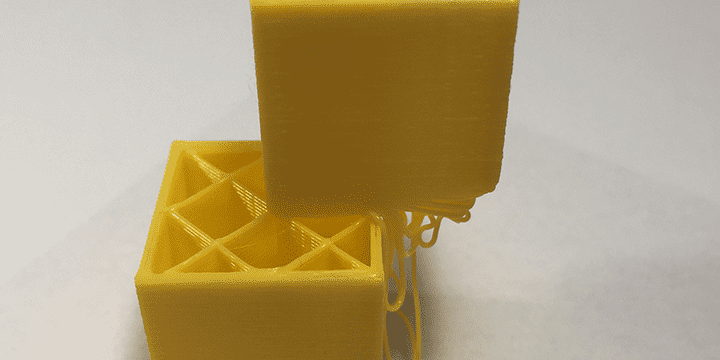Print quality troubleshooting guide
Improve the quality of your 3D-printed parts. A guide on how to fix the most common problems.
How to fix shift in layers on 3D printed parts
Shift in layers issue
The object is shifted along one or more axes. It happens when the print head somehow didn’t get to the location it supposed to according to the gcode. Unfortunately most 3D printers cannot detect this misalignment and they keep printing on the same, incorrect location. There are several reasons why the 3D printing process can get disrupted this way.
Why do layers shift and what to do
Obstructed print head
The movement of the printer was obstructed during printing which resulted in a shift along this axis. Try to move the bed and the head manually. Check the nozzle as well. If any obstructions are found, try to remove them. If this is not possible, contact your reseller.
Filament entangled
The filament can sometimes get entangled, resulting in the printer not being able to extrude the filament. If this happens, try to disentangle the filament. Make sure it is rolling off properly from the spool.
Too high speed or acceleration
The printing speed or acceleration might be too high for your printer, the motors cannot keep up and arrive at the required position in time. Since the printer does not get feedback about the position of the print head, the rest of the print will follow that location and will be misaligned. In this case, it is a good idea to decrease the printing speed. Go to the Printing settings/Expert level/Motion tab in REALvision Pro to adjust the printing speed and acceleration. You can set different speeds for the inner and outer areas of the print and to repositioning.
Print head obstructed by curled up plastic
Sometimes this problem is also caused by curled-up plastic that gets in the way of the printhead. The plastic can curl up when the cooling is not sufficient, and when the print speed is too high.
Printing settings in REALvision Pro
You can find the Printing Settings in REALvision Pro on the left panel as shown on the image on the left. The settings are available on three levels based on the users` experience with 3D printing: Basic, Advanced and Expert.
You can learn more in our Academy.
Changing printing strategy
In REALvision Pro there are two important features you can use here. You can find both of them in the Printing Settings/Expert level/Printing strategy tab/printing Options.
Z-hop strategy
It means that during the repositioning the print head will move away from the bed. This way there will be no marks left when crossing contours. The triangular mode fades the Z movement over the entire path. The square mode lifts the Z-axis, then moves the X and then the Y axis, and finally moves back on the Z axis.
Avoid printed parts option
It avoids printed parts when repositioning between areas by moving around them.
Both of these options will increase the print reliability, but will also increase the printing time.
A software program to fit your needs
If you want to get quality prints without doing 3D modeling, consider adding REALvision Pro to your 3D printer kit. We promise you easy-to-use 3D slicing software in the high-end printing industry. Suppose you are:
- A picky hobbyist with a cheap desktop 3D printer.
- Running a 3D printing service with flawless 3D prints.
- 3D printing metal parts for aerospace.
- 3D printing customizable prosthetics, implants, or casts in ABS plastic (Acrylonitrile Butadiene Styrene).
- Rapid prototyping 3D models from design software.
- Need help with calibration or material profiles.
- Finding the best 3D printer for your application.
- Exploring manufacturing processes and technology to obtain zero-waste.
In that case, we have a software plan fitting your needs.
Did you know?
FDM printing comes from the abbreviation Fused Deposition Modeling and it is also known as Fused Filament Deposition (FFD) technology, and as Fused Filament Fabrication (FFF). The spool of filament is the material used to build the 3D part by melting the plastic out of the nozzle of the 3D printer. All 3D printing filament starts out in pellet form – small granules of plastic. The filaments can be made of different types of plastic. The most commonly used plastics are PLA which is Polylactic Acid and ABS which stands for Acrylonitrile Butadiene Styrene. Both materials have favorable mechanical properties, ABS is well known for its impact resistance, toughness, and rigidity, and is also commonly used in injection molding besides additive manufacturing. PLA is known for its low melting point, high strength, low thermal expansion, good layer adhesion, and high heat resistance. It has also become a popular material due to it being economically produced from renewable resources (bioplastics).
The printer extrudes this filament line by line, layer by layer, by increasing the z-axis, and will build the 3D printed part.
